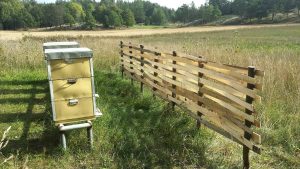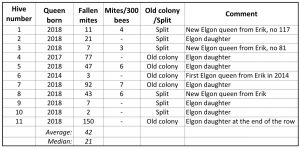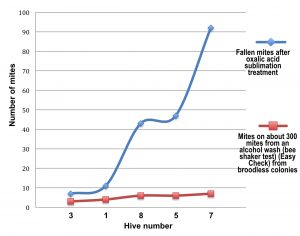 Courses with speakers are a good activity for beekeeping associations. Some time ago I lectured in a small town in eastern Sweden. I meet many nice people and personal stories. For example, the best coffee I’ve been having for a long time – freshly made at the pizzeria in the small town of Valdemarsvik.
Courses with speakers are a good activity for beekeeping associations. Some time ago I lectured in a small town in eastern Sweden. I meet many nice people and personal stories. For example, the best coffee I’ve been having for a long time – freshly made at the pizzeria in the small town of Valdemarsvik.
I shared experiences about resistance to varroa and breeding Elgon bees. One of the interesting beekeepers I met was David Fogelberg. I write about him because of his experiences with Elgons. (Click on the pictures to get them larger. Then click on the back arrow in the browser to get back to the article.)
A few years ago, David had no wind protection in front of the hives. Then he had 15-20% winter losses. After setting up wind protection, winter losses fell to below 10%. But in 2017, some colonies received old feed solutions. These colonies suffered and winter losses were therefore higher. There are more beekeepers than David who have reported higher winter losses and looks when they have given old sugar feed solutions in preparation for winter. Probably, the HMF content had increased during the storage time. Bees withstand high HMF content badly (But it’s not dangerous for humans, there is a lot in, for example, caramel).
David’s first Elgon queens
Four years ago, David bought three Elgon queens from me. Two were accepted by his bees. When he replaced queens in the rest of his colonies to daughters from these two queens he could handle his bees with short pants and without veil. It’s probably good though to wear at least a veil for safety.
– But then you used a smoker, I commented.
– Yes, David replied. I smoke the entrance and wait a minute. Smoke a little from above and wait a little with the top open. Then we work fine together, the bees and I.
David’s Elgon apiary today
Today there are daughters of these first two Elgon queen in seven of my colonies. They are mated in his apiary. One of the original queens is in the eighth colony, now four years old (and five years in 2019 if she survives, her colony is strong).
This year he bought three new Elgon. In total, he is wintering 11 colonies in his apiary this year. David uses the standard frame size in Sweden, 366 x 220 mm (14.41” x 8.74”). He uses the standard wax in Sweden with 5.1 mm cell size (five cells to the inch). It’s the cell size of the first foundation from A. I. Roots from America milling rollers in 1876. I wonder if it’s the standard cell size in any other country.
The neighbor beekeeper
It’s about 1 km (0.6 mile) to three apiaries to another beekeeper. There are about 15 Buckfast colonies in each of these beeyards. Within 20 km (12.5 miles) of his Elgon apiary, this beekeeper has a total of about 900 bee colonies.
Small amounts of mites
In 2017, David treated his colonies with fumed oxalic acid in early December when there were some degrees above freezing. From most colonies, it fell less than 15 mites because of the treatment. From those which it fell more than 15 mites he later treated once again. From the worst it fell 30-40 mites the first time.
I pointed out to him that there were very small number of mites. The colonies had certainly not needed any treatment at all.
Bee shaker test
I suggested that he should do a bee shaker (alcohol wash) test test this year (see, for example: http://www.elgon.es/diary/?p=67195 ) before deciding if the colonies needed any treatment. It was in mid October I talked to him about it. At that time of the year elgon bees have no brood, so I pointed out that a bee shaker test is not directly comparable to such a test during the brood season. During the season 2/3 of the mites are in the capped brood and not on the bees. This means that monitoring the varroa level with a bee shaker test (alcohol wash) when there’s no brood gives a three times higher value than during the summer season with normal amount of brood. Thus a the figures from a broodless period should be divided by three to get a value comparable with test results during the season with brood.
David made a table of his varroa monitoring this fall. One can see that some elgon daughters have a bit more mites than others. And some colonies have very few mites. For finding out the breeding value of these colonies it would have been good to wait with any eventual treatment until spring. But then we had not had these figures. You can at least see from them that there are interesting colonies to investigate more. Yes, really all the colonies are interesting. It can also be noted that the beekeeper with 900 colonies most probably managed the treatment of varroa mites effectively, otherwise one could have expected that the varroa levels could have been higher due to reinvasion. One might also conclude that it’s not a disaster if an elgon queen mates with some other drones than elgon ones. This is because a queen mates with as many as about 20 drones on average. And It’s probable that at least some elgon daughters have mated with more than just a few buckfast drones. Three colonies, no 4, 5 and 6 were not placed at David’s home during 2017 but in the local association’s apiary used for courses to teach beginners. In this apiary the colonies now have only daughter queens of David’s original elgon queens. David’s three colonies were brought back home in 2018. The three colonies were strong and splits were taken from them. The new queen in no. 5 is a daughter of no. 4 (a swarmcell from that hive).
Varroa level and treatment
David made bee shaker tests from about half of his colonies in the third week of October. The colony that had the highest number showed 7 mites. Those who had at least were two of the new queens from this year, 3 and 4 mites. 7 mites correspond to a varroa level during the brood season of less than 1%. The colonies were treated a year ago.
In mid-November now this year David treated all 11 colonies with fumed oxalic acid. The downfall of mites after treatment varied between 2 and 150. Concerning the colonies from which bee shaker samples were taken, those dropped between 7 and 92 mites.
One can see a connection between the monitored varroa level and dead mites dropped after the treatment. However, there is no linear relationship, which may have more than one explanation. But, the figures of varroa level from the measurements are enough good to provide a sufficiently reliable basis for making a decision if a treatment is desirable as soon as possible or if the hives can wait for a new decision after another monitoring with the bee shaker in spring. Concerning David’s bees, if it had been up to me to make a decision, I would have waited until spring, first making another varroa monitoring bee shaker test before once again deciding if to treat or not. If the varroa level then would be higher than 3 % or not (more than or fewer than 9 mites on 1 dl of bees (300 bees). But then we would not have obtained these comparative figures, which have given us more knowledge.
Number of mites going into winter
I remember a meeting with the Nordic Baltic Council (with representatives from the bee associations from the different countries) many years ago. Then it was said from Sweden that the goal of the treatment was that all colonies should be going into winter with less than a few hundred mites. In Finland the limit was set to 100 mites.
Conclusions
Two conclusions about David’s bees:
– No colony hadn’t really needed any treatment to survive the winter.
– The bee shaker samples gave sufficient information for such a decision. The next varroa level test were then to be done in early May.
Thank you David
But if David had not done both the varroa level test in October and the oxalic acid treatment in November, we would not have had these informative figures. The figures give a graph that point out that there is no linear relationship between the varroa level test and the mite dropping after the treatment. It may be due to different reasons. That would be interesting to find the answer to. It is though enough to say that the figures from the varroa level tests are sufficient to provide you with a sufficiently good information to be able to make the right decision to treat or not to treat.
And the most important thing in all breeding work for all beekeepers is always to identify the least good colonies and replace the queens in these. They can get queens or mature queen cells, from some of the other colonies is a good choice.




Hi Erik, David,
you say the counting with alcohol wash was in october when the bees were broodless.
Then why has a colony tested in october zero mites and later on after oxalic vaporizing 150 mites falling?
Or was it not tested?
It was end of row, so maybe reinfested?
After being treated the year before they came out of winter with low mite numbers.
Those mite numbers are still very low.
They are much lower than our treated beekeepers´ colonies are ( AS and OS drop more than 100 mites at the average, mostly 200-400)
I think all would have survived without winter treatments.
Very good to monitor so you know not to endanger colonies by not treating.
David: great management to place a windbreak!
Sibylle
Hi Sibylle
The 150-colony was not monitored with the bee shaker. The – tells you that. About half of the colonies were monitored in October. Why this colony had the highest number of mites may have been contributed by the fact that it was at one the end of the row. The colony at the other end had fewer mites. It was a split with one of the new queens. Yes, the numbers are all quite low actually. I think all numbers under 1000 after a treatment like this are low.
There is though the fact that in many places where beekeepers are treating two, three and four, five times a year to get really low numbers of mites, it seems the immune system are so damaged colonies are dying anyway. So for such colonies 1000 mites is a high number!
Also these many treatments with rising virus levels may be an answer to why there are more queen problems as Bill is reporting.
Erik
Hello from Baltimore,
I wonder why here in USA now that acid vaporization is used everywhere, why queen events are also very high here as well? I really think acid treatments are harming the queens which in turn causes the colony to abort their queens. Seems in other countries, beekeepers have colonies with several year old queens despite the beekeeper gassing their colonies with acid vapor.
Thanks for your excellent thought proviking blog.
Hi Bill
Yes, beekeepers are looking for new treatments all the time. It tells me they are not really satisfied with those they are using. They are crutches all of them, only to be used until they are getting rid of. Then the microbes can come back to a healthy status. I suspect virus levels have risen so high in the colonies due to more treatments than just oxalic fuming, or many fumings a year. David has fumed most of his colonies once a year with 3 grams. And yes, I was surprised to see that one of the original Elgons with him was still there 4 years old, and maybe hopefully will be there as five year old in spring.
Erik
Hi Bill,
the formic acid makes the queen´s problems, the oxalic vaporizing is not as dangerous, it´s rather dangerous to the beekeeper if he is not protecting himself.
Oxalic seems to kill microorganisms though, mostly fungi, which the bees need for their digestion.
Myself, I can´t understand anyone monitoring for mites by a treatment.
The moment the treatment is used it´s not possible to evaluate the mite resistance or tolerance. State is, they are a treated colony. The cow is on the ice already then.
No resistance breeding possible except use the bees for better queens.
But treatment free colonies, hopefully at least two seasons and one winter, better two winters free of chemicals, are necessary in a project of resistance breeding in my eyes.
And everyone using resistance bred queens should go on with the selection, no matter how the genetics are watered down by the environement.
Means: some risks.
I´m with Erik, checking for mite numbers in spring and again in late summer to see the numbers rise or not. If the bees can hold the mites at bay throughout the season and show no virus disease or not many sick bees, and mite numbers stay the same, the defense is present. I learned that in sweden, listening to him.
Coming out of winter strong or weak is a sign too.
And it´s probably best to do the alcohol wash when the colony is strong and can replace the bees quickly.
Sticky boards can be used all the time without killing bees.
Sibylle
Hi Erik,
thanks for the correcting comment to the statistics.
I´m fascinated by this story.
With only one OAV treatment David keeps alive his bees in a treater´s crowded area.
My personal belief is the elgons have the grooming trait added to the VSH.
Some speculations:
The grooming behavoiur may be triggered by movements and behaviours of the infested bees and start a learning behaviour which leads to an epigenetic behaviour.
Perhaps coming from the monticola influence?
The VSH ( which I see in my hives done) might be decreased by treatments which disturb the smell of the interiour pheromones or by the stress while treatments are done, or with splitting to much. I think the expression of this trait is influenced strongly by beekeeper´s managements.
The grooming behaviour might be increased by treatments, because of the stress of cleaning the hive from chemicals ( I saw my bees do cleaning in a desperate way when I put in the thymol ,and they propolised the pads) or perhaps it is not influenced much.
Grooming is accelerated by sugar shakes too, it seems. Some people keep alive their hives just doing sugar shakes now and then in season.
The grooming trait is difficult to monitor and not of interest to many, the VSH is much more scientifically checked and bred for.
I only know of one breeder who breeds for grooming and mite biting, Alois Wallner.
Well, my friend Stefan who keeps his elgon mutts treatment free for years right next to his carniolan treated hives is an example to me because it works for him too. No reinvasion if he treats thoroughly. And so far his mites are not getting more virulent and his elgons survived since 2013 completely without treatments and without drone cutting.
No isolated mating place too. 🙂
I will keep you updated about that.
Sibylle